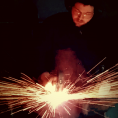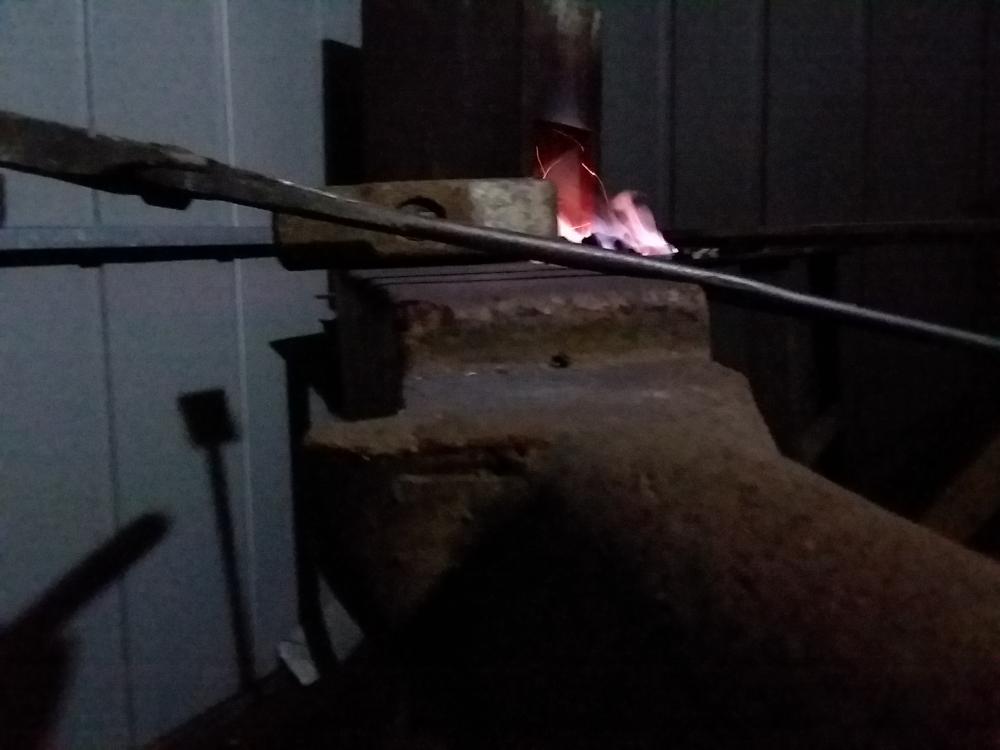-
Posts
733 -
Joined
-
Last visited
Content Type
Profiles
Forums
Articles
Gallery
Downloads
Events
Everything posted by Will W.
-
Agreed. The idea that the ancient peoples of the world had a better understanding of any field of science than modern man is a fallacy through and through. Example: imagine trying to explain chromium and stainless steel to the greatest smith in all of Bohemia. Good luck!
-
Nope. You are aware that forge welding lowers the carbon content of steel, right? And youre also aware that they had to do a LOT of welding to homogenize the steel? You are implying that "real" damascus had well over 100 points of carbon? That is simply incorrect. I also have my doubts about your whole carbon nanotube theory. A nanotube cannot form inside of a solid. That would imply a void in the center of said tube. Please cite your sources. If it seems like im being rude, i apologize, i dislike misinformation. Du, imagine if we gave a 14th century smith a properly heat treated stock removal D2 knife. They would literally drool.
-
Despite the trouble you mentioned, i think the grinds look good on them. I would have completely cleaned the flats between the plunge and spine, considering that they will be in contact with food. But this is a matter of preference i suppose. I really like the handle on the larger one, with the coarse grain. Fit and finish looks really nice on both. Overall, i think they came out great! Nice work. They will serve him well for a long time to come.
-

looking for trenton 258 information
Will W. replied to Brian Evans's topic in Anvils, Swage Blocks, and Mandrels
Agreed. She will treat you well, im sure. -
Not hot enough, by the looks. What kind of steel was it? What color did it appear to be? Was there smoke or steam coming off of the steel?
-
The way i see it, John, youve got 3 swords and 4 chisels right there.
-
Maybe you could use acid to remove it? You would want a relatively strong acid so it doesnt take a very long time to do it. Just a thought.
-

Where to get mild steel for welding?
Will W. replied to CreekSideForge's topic in Knife Class Reference Material
Both sentences you wrote are exactly why you should start with mild. Get your head wrapped around how big the billet should be, how much wire to use, how many heats before you can remove the wire, etc, BEFORE you make the first cut on the good blade steel. -
Hello everyone. Anybody ever try to etch damascus using Coca Cola? Or a similar acidic soda? The pH of Coca Cola is 2.5, comparable to Citric acid which is 2.2, so I imagine it would work.
-

Where to get mild steel for welding?
Will W. replied to CreekSideForge's topic in Knife Class Reference Material
Sounds like a plan. You dont need the 1084 on the outside, ive had 15n20 on the outside, but it can be a bugger welding to itself. If you have one piece of 1084 on the outside and a piece of 15n20 on the other end, it works well. That way, you can cut it in two (or more) and stack the 1084 against the 15n20 so you never have a double layer. Makes the pattern more consistent. I try to keep the intial billet around 5 inches long so i can have the entire thing right in the hottest part of the fire, and all up to the same temperature. I use a charcoal forge, so idk if its any different using gas. I dont like welding one half and then rotating to weld the other half. Some people have success this way, but ive found it simpler and more effective to weld the entire length in the same heat. Oh, and NEVER strike the billet below red color. You may not break a weld on the first hit, or maybe even the tenth, but thats unnecessary stress that will only hinder you. -

anvil, somebody help me?
Will W. replied to igrindwell's topic in Anvils, Swage Blocks, and Mandrels
She is a lady! -
Well bladesmiths also use 5160 extremely commonly, and thats a lower C steel than 1070. Its important to remember that C is not the only thing that matters. Metallurgy is complex. It will work as a kitchen knife steel, but just like any non stainless knife, it must be cared for and maintained, not just thrown in the dishwasher. Any of the 10xx series steels are really easy to forge and heat treat. They have a very wide forging temp range (compared to tool steels anyways) so as long as you dont hammer on it when its colder than red or burn it, youre good to go. For heat treating, normalize, heat to critical, and oil quench. Tempering depends on intended use. Like i said, very simple steel. Im reasonably certain that all of this information is in the stickies. I recommend reading up on them. Youll walk away knowing a lot more than you came in with, even things that you didnt realize you needed to know.
-

Where to get mild steel for welding?
Will W. replied to CreekSideForge's topic in Knife Class Reference Material
Never a problem. Always willing to (try to) help. Lord knows i wouldnt be anywhere near where i am now without the help of the forum folk. Allow me to reiterate that you should read up on the stickies and knife classes. Lots of good info there, put together by masters. It will shorten the learning curve, trust me. And do not allow yourself to become frustrated when you fail. Learn from your mistakes, disect your failed pieces, research and ask informed questions if you do not understand. -

Where to get mild steel for welding?
Will W. replied to CreekSideForge's topic in Knife Class Reference Material
Yes or no, depending on a lot of factors. If you get it up to forge welding temp enough times, that carbon will become homogenous. San mai is tricky. I would recommend doing standard stacked layers of high carbon steel before trying that, and only that after practicing with mild. This way, you will know how to weld high carbon, and how to weld the layers together efficiently and with as few heats as possible, so you can control the migration in your san mai goal. -

Where to get square/round stock
Will W. replied to Pr3ssure's topic in Blacksmithing, General Discussion
It works well. Better than i expected, to be honest. I was searching for a way to get away from grinding the paint off (smells terrible, cant imagine its good for health) so i tried the HCl, and was satisfied with the results. Never used sodium hydroxide, ill have to try that sometime, ive got some in the shop. Perks of being a backwoods chemist . I really truly dont mean to sound snide and rude, but... umm, yeah! -

Where to get mild steel for welding?
Will W. replied to CreekSideForge's topic in Knife Class Reference Material
Since this was posted in the knife making section, its safe to assume you are pattern welding for blades, no? If that is the case, then you dont want to use mild steel. The carbon content is far too low, and even if you weld it to a high carbon steel, carbon migration through the two pieces will render the high carbon steel a moot point. And after decarb, youre pretty much not going to have anything even close to resembling blade worthy steel. Recommended steel for beginners to try to make damascus from is usually 1080 or 1095 and 15n20. I would recommend learning to forge weld mild steel to mild steel just to practice welding. You are going to mess up a few times (or a whole lot if your case is similar to mine.) Better to learn the necessary skills on cheap mild than expensive blade steel. Also, read the stickies that are all over this section of the forum. Most questions you may come up with have already been answered there, including most of the info i just typed, and much, much more. -

Where to get square/round stock
Will W. replied to Pr3ssure's topic in Blacksmithing, General Discussion
HCl and a wire brush work a treat for stripping paint, especially those thick layers of tough paint found on many tools like crowbars. -

What did you do in the shop today?
Will W. replied to Mark Ling's topic in Blacksmithing, General Discussion
-

looking for trenton 258 information
Will W. replied to Brian Evans's topic in Anvils, Swage Blocks, and Mandrels
Thats just a fraction under 2 dollars per pound. It looks like its in pretty nice shape too. Pending a rebound test and thorough inspection for cracks, etc, I would say thats a heck of a deal, and would snatch that right up, were I you. Now thats not to say you cant try to offer 450. Haggling is fun! -

First Crucible Steel Run, and Forging.
Will W. replied to DanielC's topic in Smelting, Melting, Foundry, and Casting
Indeed. But what am i looking at? I realize its the etched surface finish, but what gives it that pattern? The crystalline structure? I know nearly nothing about this, mind you. -

Where to get square/round stock
Will W. replied to Pr3ssure's topic in Blacksmithing, General Discussion
Well said, Irondragon. -
If it has rust (red iron oxide, Fe2O3) then it is likely steel, or at least contains a decent amount of iron. If its a dull grey, its likely galvanized. Do not attempt to melt it, zinc is bad bad bad. I wouldnt even bother with the magnet either. If it has enough iron to create rust, it will be magnetic.
-
A lot of people call various metal roofing "tin" when in reality, it is not made of the actual metal tin. A lot of the stuff is actually steel or aluminum. Are you sure this is actually tin? How malleable is it? Does a magnet stick to it? Try melting a little piece of it. Steel, aluminum, and tin all have WAY different melting points, so you should be able to tell with a fair degree of certainty that way.
-

Decided to try an ax with some file work
Will W. replied to Zachary's topic in Axes, Hatchets, Hawks, Choppers, etc
Love the file work, well done. -

Where to get square/round stock
Will W. replied to Pr3ssure's topic in Blacksmithing, General Discussion
There are numerous websites that also sell literally any steel. Online metals sells A-36 and 1018 in every size you could ever want, Hudson Tool Steel sells advanced tool steels such as A-2, O-1, and S-5, and companies like Texas Knifemakers Supply and Jantz sell lots of simple carbon steels like 5160 and 1080. I have bought from all of these companies in the past, and have had good service from them all.

